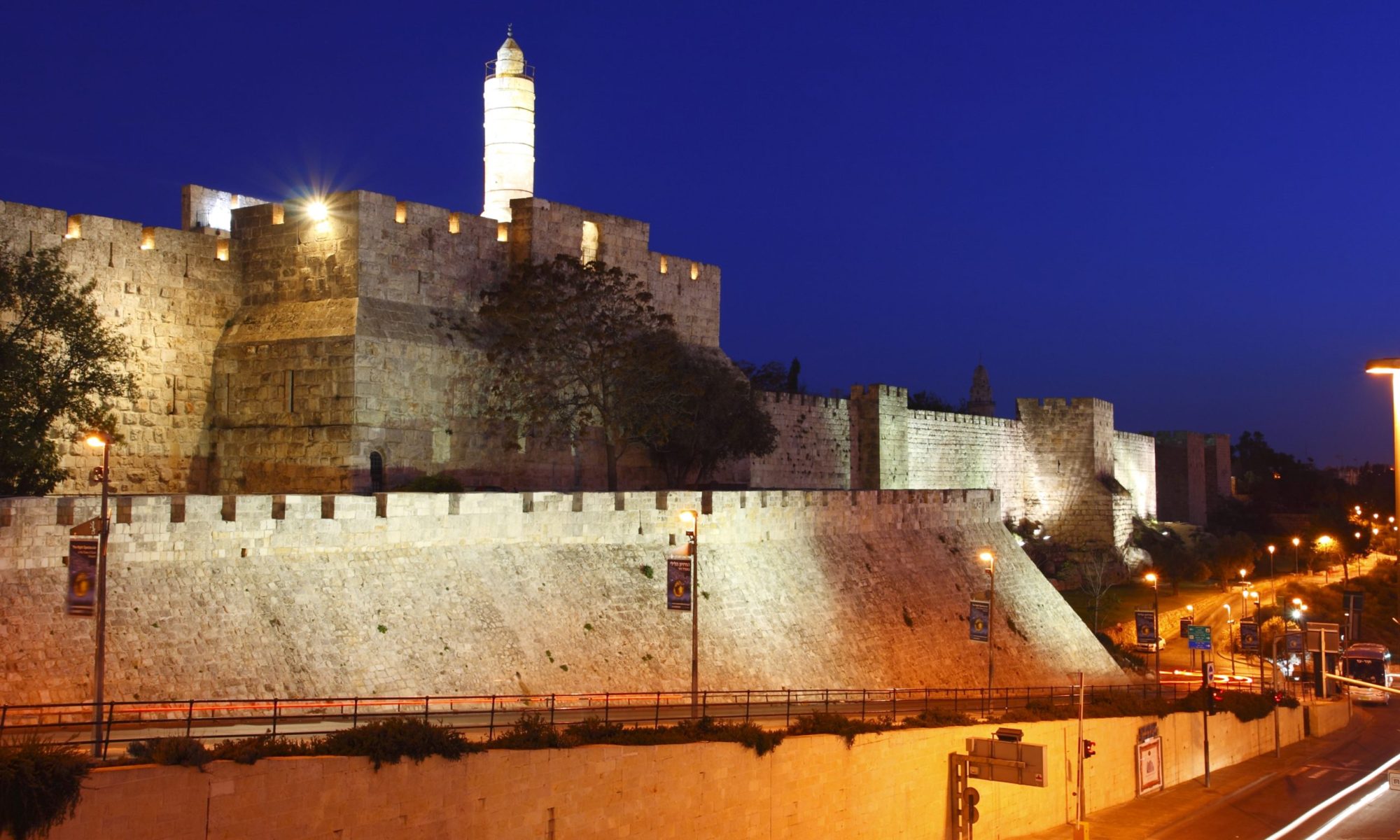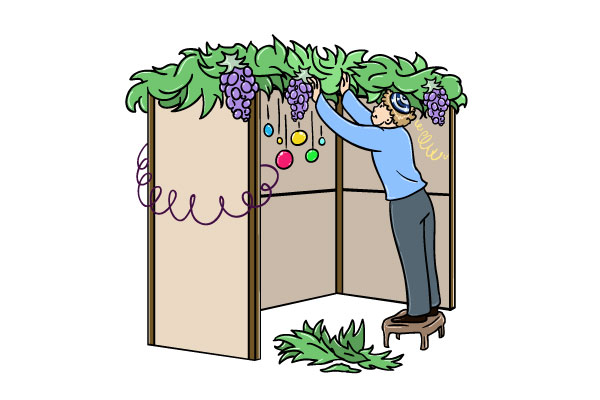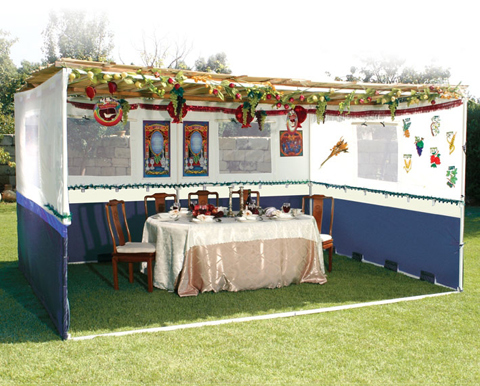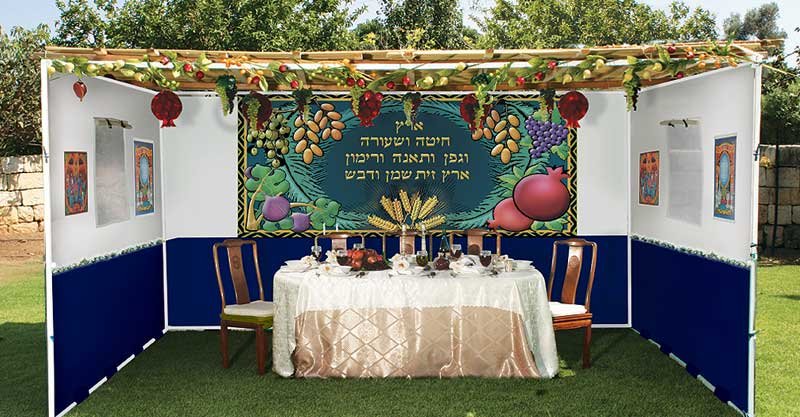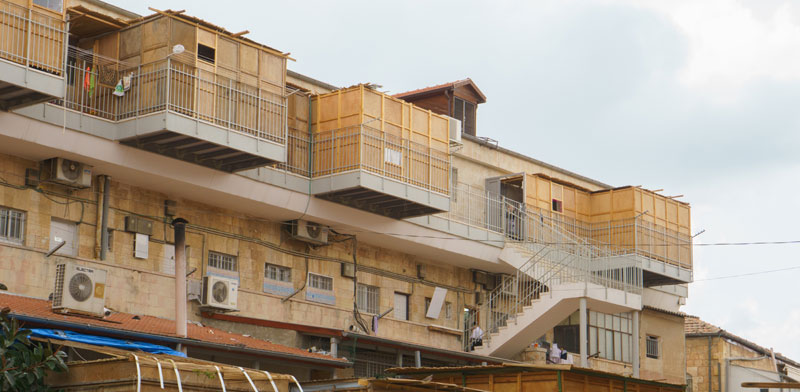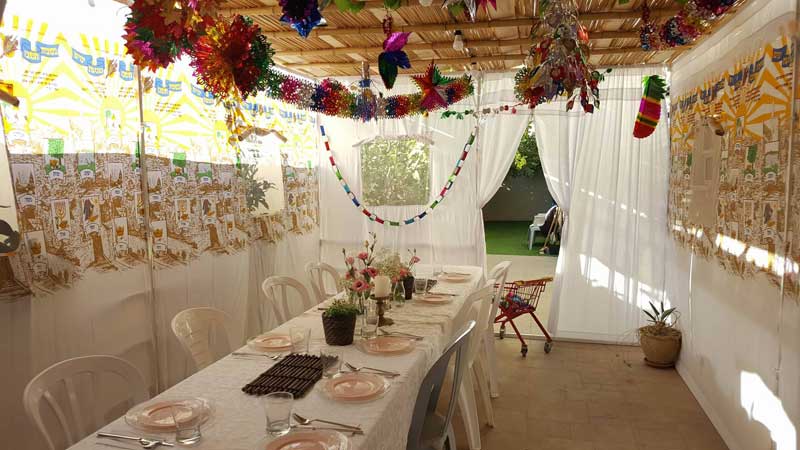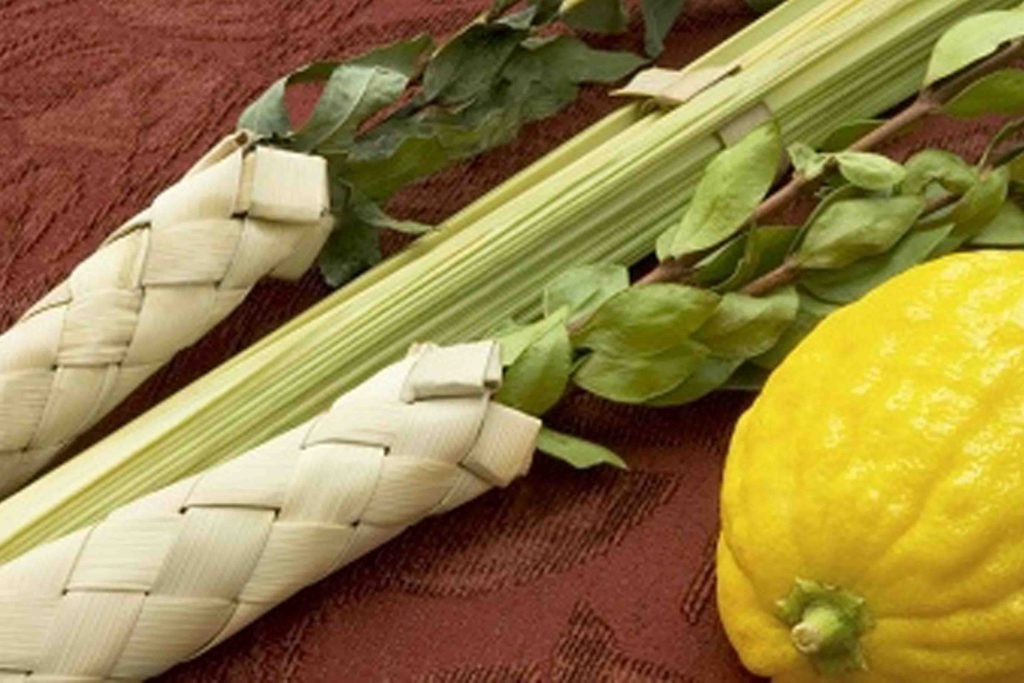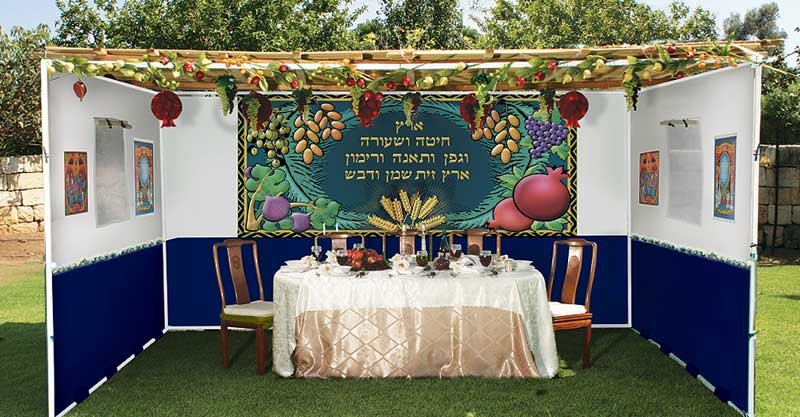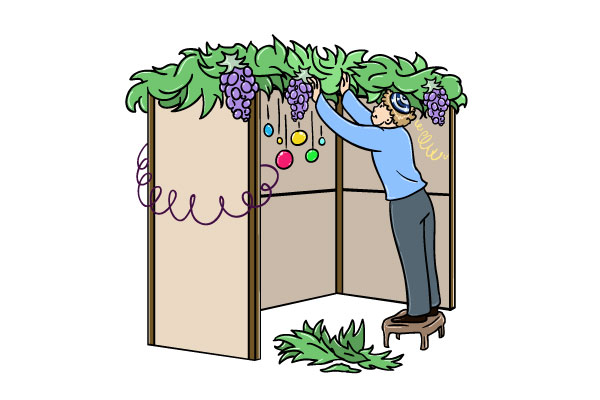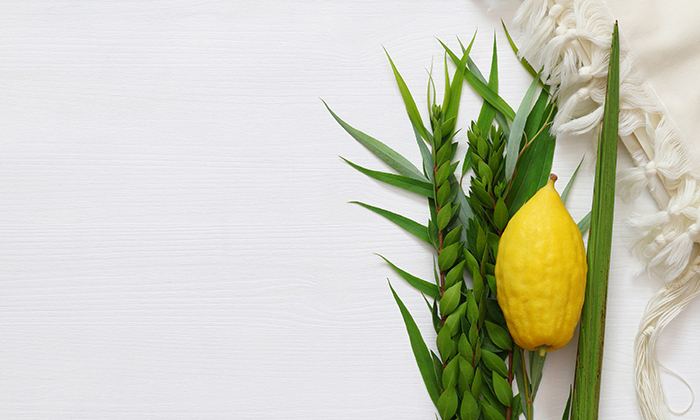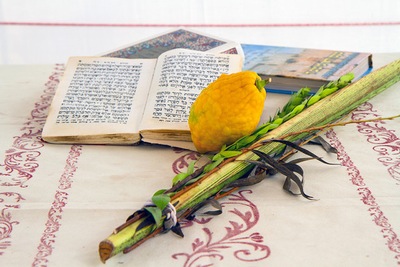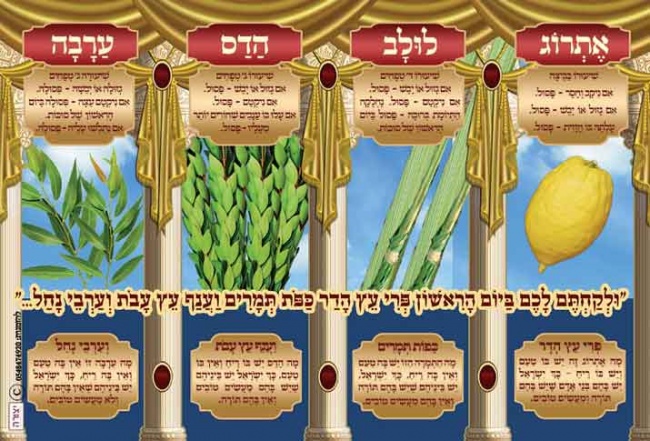
Sukkot – The Feast of Tabernacles
The seven days of Sukkot—celebrated by dwelling in the sukkah, taking the Four Kinds, and rejoicing —are followed by Simchat Torah.
Sukkot—when we expose ourselves to the elements in greenery-covered huts—commemorates God sheltering our ancestors as they traveled from Egypt to the Promised Land. The Four Kinds express our unity and our belief in God’s omnipresence. Coming after the solemn High Holidays, it is a time of joy and happiness
The first two days (or one day in Israel) are yom tov, when work is forbidden, candles are lit in the evening, and festive meals are preceded with Kiddush and contain challah dipped in honey (see the recipe for sweet Challah Bread in Rosh Hashanah). The remainder of the days are quasi holidays, known as chol hamoed. We dwell in the sukkah and take the Four Kinds every day (except for Shabbat, when we do not take the Four Kinds)
What is Sukkot (this year, October 2-9, 2020)?
Sukkot is a weeklong Jewish holiday that comes five days after Yom Kippur. Sukkot celebrates the gathering of the harvest and commemorates the miraculous protection God provided for the children of Israel when they left Egypt. We celebrate Sukkot by dwelling in a foliage-covered booth (known as a sukkah) and by taking the “Four Kinds” (arba minim), four special species of vegetation.
The first two days (sundown on October 2 until nightfall on October 4 in 2020) of the holiday (one day in Israel) are yom tov, when work is forbidden, candles are lit in the evening, and festive meals are preceded by Kiddush and include challah dipped in honey.
The intermediate days (nightfall on October 4 until sundown on October 9 in 2020) are quasi holidays, known as Chol Hamoed. We dwell in the sukkah and take the Four Kinds every day of Sukkot (except for Shabbat, when we do not take the Four Kinds).
The final two days (sundown on October 10 until nightfall on October 11 in 2020) are a separate holiday (one day in Israel): Shemini Atzeret / Simchat Torah.
The significance of Sukkot
Of all the Jewish holidays, Sukkot is the only one whose date does not seem to commemorate a historic event. The Torah refers to it by two names: Chag HaAsif (“the Festival of Ingathering,” or “Harvest Festival”) and Chag HaSukkot (“Festival of Booths”), each expressing a reason for the holiday.
In Israel, crops grow in the winter and are ready for harvest in the late spring. Some of them remain out in the field to dry for a few months and are only ready for harvest in the early fall. Chag HaAsif is a time to express appreciation for this bounty.
The name Chag HaSukkot commemorates the temporary dwellings God made to shelter our ancestors on their way out of Egypt (some say this refers to the miraculous clouds of glory that shielded us from the desert sun, while others say it refers to the tents in which they dwelled for their 40-year trek through the Sinai desert).
Dwelling in the Sukkah
For seven days and nights, we eat all our meals in the sukkah and otherwise regard it as our home. Located under the open sky, the sukkah is made up of at least three walls and a roof of unprocessed natural vegetation—typically bamboo, pine boughs or palm branches.
(Read more here: How to Build a Kosher Sukkah)
The goal is to spend as much time as possible in the sukkah, at the very minimum eating all meals in the sukkah—particularly the festive meals on the first two nights of the holiday, when we must eat at least an olive-sized piece of bread or mezonot (grain-based food) in the sukkah. Some people do not eat or drink anything outside the sukkah, and some even sleep in the sukkah
Taking the Four Kinds
Another Sukkot observance is the taking of the Four Kinds: an etrog (citron), a lulav (palm frond), three hadassim (myrtle twigs) and two aravot (willow twigs).
On each day of the festival (except Shabbat), we take the Four Kinds, recite a blessing over them, bring them together and wave them in all six directions: right, left, forward, up, down and backward. The sages of the Midrash tell us that the Four Kinds represent the various personalities that comprise the community of Israel, whose intrinsic unity we emphasize on Sukkot.
Hoshanah Rabbah – The seventh day of the holiday
Every day of Sukkot we say Hallel, a collection of psalms of praise (Psalms 113-118) as part of the morning prayer service. Every day aside for Shabbat, we recite Hallel while holding the Four Kinds, waving them in all directions at certain key points in the service, which are outlined in the siddur (prayerbook).
Afterward, we circle the bimah (the podium on which the Torah is read) holding the Four Kinds, reciting alphabetically arranged prayers for Divine assistance known as Hoshanot.
The seventh day of the holiday is known as Hoshanah Rabbah. This is the day when our fates for the coming year—which were signed on Rosh Hashanah and sealed on Yom Kippur—are finalized. On this day, we circle the bimah seven times. We also say a short prayer and strike the ground five times with bundles of five willows (also known as Hoshanot)
Sukkot during the time the Temple in Jerusalem existed
In the days of the holy Temple in Jerusalem, there was a special regimen of sacrifices that were to be brought on the altar. On the first day, no less than 13 bulls, two rams, and 14 lambs were to be sacrificed. Every day, the number of bulls was depleted by one. All in all, 70 bulls were brought, corresponding to the 70 nations of the world.
Along with Passover and Shavuot, Sukkot is one of the Shalosh Regalim, the three annual pilgrimages, when every male Jew was to be in Jerusalem. Every seven years, on Sukkot, the king would read aloud from the Torah to the entire nation—men, women and children. This special gathering was known as Hakhel.
(Read more here: What Is Hakhel and how is it done today where there is no Temple?)
Water and Joy
On Sukkot, God determines how much rain will fall that winter (the primary rainy season in Israel). Thus, while every sacrifice in the Temple included wine libations poured over the altar, on Sukkot, water was also poured over the altar in a special ceremony. This ritual engendered such joy that it was celebrated with music, dancing and singing all night long. This celebration was called “Simchat Beit Hasho’evah.”
Even today, when there is no Temple, it is customary to hold nightly celebrations that include singing and dancing (and even live music during the intermediate days of the holiday).
This holiday is so joyous that in Talmudic times, when someone said the word chag (“holiday”) without specifying which one, you could know that they were referring to Sukkot.
(Read more here: The Joyous Water-Drawing Ceremony)
Shemini Atzeret / Simchat Torah: even more joy
The Torah tells us that after the seven days of Sukkot, we should celebrate an eighth day. In the diaspora, this eighth day is doubled, making two days of yom tov. On the final day, it is customary to conclude and then immediately begin the annual cycle of Torah reading, making this day Simchat Torah (“Torah Celebration”).
Although the eighth day follows Sukkot, it is actually an independent holiday in many respects (we no longer take the Four Kinds or dwell in the sukkah). Diaspora Jews eat in the sukkah, but without saying the accompanying blessing (there are some who eat just some of their meals in the sukkah on the eighth day but not the ninth).
The highlight of this holiday is the boisterous singing and dancing in the synagogue, as the Torah scrolls are paraded in circles around the bimah.
Why do Christians celebrate the Feast of Tabernacles?
The biblical importance behind this Feast
The Feast of Tabernacles is one of the seven Feasts of the LORD. It is important to understand that these Feasts are of the LORD. God said, “these are My feasts” (Leviticus 23:2b), and he commanded the Israelites through Moses to observe these Feasts throughout their generations. When we celebrate these Feasts, we are reminded of what God has done in the past and will perform in the future. Let us explain the significance of these Feasts and why Christians should celebrate the Feast of Tabernacles.
These Feasts are holy convocations. The Hebrew word for “feast” is “mo’ed,” and one of its important meanings is “appointed time.” The Hebrew word for “convocation” is “miqra,” which is translated as “rehearsal.” So, the seven Feasts of the LORD are God’s appointed times and dress rehearsals for significant events, as ordered and predetermined by God.
Our God is a God of pattern and order. He created the heavens, the earth and all the living things in six days, and then He rested on the seventh day. The number “7” in Hebrew numerology denotes completion. These seven Feasts of the LORD are not only the appointed times for the dress rehearsals, but also represent God’s pattern and order for the first coming of Jesus, as the Lamb of God and His second coming, as the King of kings and Lord of lords (Revelation 19:16).
The first four feasts were already fulfilled in Jesus’ first coming. He first came as the savior of the world, the Passover Lamb of God, the sinless Son of man. The second feast is the Feast of Unleavened Bread. The third feast is the Feast of First fruits, and the fourth feast is the Feast of Weeks or Pentecost as we know it. The remaining three Feasts are to be fulfilled at the return of Jesus as the King of kings and Lord of lords.
We are rehearsing the return of Jesus when we participate in the last three Feasts, the Feast of Trumpets, the Feast of the Day of Atonement (Yom Kippur) and finally the Feast of Tabernacles where God will tabernacle with us during the millennium period.
The Feast of Tabernacles is a seven-day celebration (Leviticus 23:34). The Jewish people are commanded to dwell in booths to remind them that God “brought them out of the land of Egypt” (Leviticus 23:43). Seven again is a number of completion. Could this signify the completion of an important event in the timeline of God? Could this be the beginning when God tabernacles with man in Jerusalem during the millennium years? Only Abba Father knows, and with the passing of time we will also know.
The first day of the Feast of Tabernacles is a holy convocation, a holy rehearsal, a Sabbath day of rest (Leviticus 23:35). The Feast of Tabernacles is also the dress rehearsal where nations gather in Jerusalem to “worship the King, the LORD of hosts, and to keep the Feast of Tabernacles” (Zechariah 14:16b). Annually, the ICEJ organizes the Jerusalem March as a dress rehearsal for the fulfilment of Zechariah 14:16. Come to the Feast of Tabernacles to experience the joy of marching with the nations on the main streets in the heart of Jerusalem. You will have the unique opportunity to demonstrate your love for Israel and her people, as you shower them with gifts and more importantly, with your presence.
There is another holy convocation on the eighth day, only this time, it is especially mentioned as “a sacred assembly, and you shall do no customary work on it.” (Leviticus 23:36). The number “8” points to a new beginning. Could this be the dress rehearsal for the sacred creation of “a new heaven and a new earth” (Revelation 21:1) at the completion of the millennium years? Again, only time will tell.
When God said, these Feasts are “appointed times” (Leviticus 23:4b), we believe He is calling His people to assemble on these appointed times to meet with Him. These appointed times are God’s open invitations or “seasonal portals” to receive His blessings. We believe your presence in Jerusalem during the Feast of Tabernacles is positioning yourself in the right place at the right time to receive God’s blessings.
There are special places located geographically that attract angelic presence and activities. In Genesis 28:10-19, Jacob stepped into a “certain place” and “behold, a ladder was set up on the earth, and its top reached to heaven; and there the angels of God were ascending and descending on it.” This place is called Bethel, the House of God where Jacob received his special revelation from God that his descendants shall be as the dust of the earth, and through him all the families of the earth shall be blessed. Jerusalem is another anointed place, a geographical portal where revelation from God is released.
We believe coming to Jerusalem during the Feast of Tabernacles, where seasonal and geographical portals come into alignment, will bring amazing blessings and revelation from God for your life. Come with heightened expectancy to the Feast of Tabernacles, especially in this 70th year of Israel as a reborn nation. This is your appointed time to commune with your God.
We receive amazing understanding of the Word and love for our Jewish brethren every time we come to celebrate the Feast of Tabernacles in Jerusalem. Those who came with us also experienced miracles of healings, restored relationship with Abba Father and deeper understanding of the Bible.
When you celebrate the Feast of Tabernacle in Jerusalem. You will certainly be blessed!
Food in the feast
There is nothing more Jewish and more comforting than a good Chicken Soup, so here is a one recipe (there are many variations) for traditional chicken soup
Finally, few words to summarize the Jewish holiday of Sukkot and its meaning
